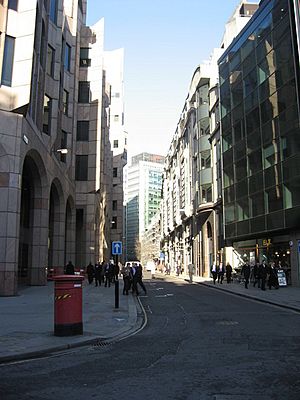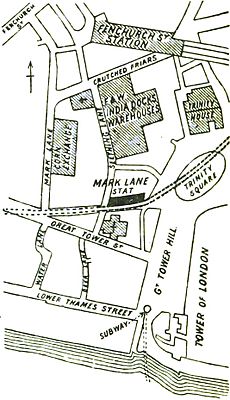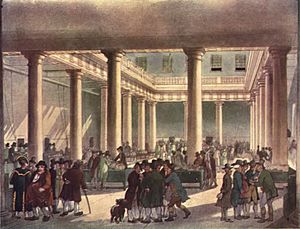Mark Lane, London facts for kids

Mark Lane in 2008, viewed from Great Tower Street
|
|
| Location | London, United Kingdom |
|---|---|
| Postal code | EC3 |
| North end | Fenchurch Street |
| South end | Great Tower Street |
Mark Lane is a historic street located in the City of London, England. It connects two other well-known streets: Great Tower Street and Fenchurch Street. This street was once so famous that a nearby underground station, opened in 1884, was named Mark Lane. It was later renamed Tower Hill in 1964 and closed a few years later. For over 200 years, Mark Lane was famous for its corn exchange, which was the main market in London for buying and selling corn, grain, and seeds.
Contents
What You'll Find on Mark Lane
Mark Lane starts as a two-way street off Fenchurch Street at its northern end. Here, you can find Dunster Court, which is home to the Worshipful Company of Clothworkers. This is one of London's ancient trade guilds, which are like old clubs for people who work in the same business.
Today, Mark Lane is filled with many offices and places to eat. If you want to visit, the closest underground station is Tower Hill, which serves the Circle and District lines. The nearest main train station is Fenchurch Street, offering services to areas east of London and Essex.
The Old Church Tower
Near the northern part of Mark Lane, there used to be a very old church called All Hallows Staining. It was a medieval church, meaning it was built a long time ago, around the Middle Ages. Most of the church was taken down in 1870. However, its old bell tower, built in the 12th or 13th century, still stands today. You can see it at the corner of Mark Lane and Dunster Court. This tower is a "Grade I listed building," which means it's a very important historic building that needs to be protected.
How Mark Lane Got Its Name
According to John Stow, a writer from the late 1500s who studied old London, the name "Mark Lane" comes from a cattle market that used to be held there. A "mart" was an old word for a market.
The Famous Corn Exchange
In the 1800s, when people said "Mark Lane," they often meant London's main market for corn and grain. This market was called the London Corn Exchange.
The First Corn Exchange
The original Corn Exchange opened in 1747. It was designed by an architect named George Dance the Elder. It had a special design with a courtyard open to the sky.
Two Exchanges and One Big Market
In 1826, some traders who were not happy with the old exchange decided to start their own. They built a new exchange right next to the old one on Mark Lane. This new building opened in 1828.
Later, in 1882, the original Corn Exchange building was mostly torn down and replaced with a much bigger one. Both the old and new exchanges continued to operate side-by-side until 1926, when they finally joined together.
Modern Corn Exchanges
The new exchange building from 1828 was taken down in 1931. Ten years later, the larger 1882 Corn Exchange was destroyed during the Blitz, which was a series of bombings in London during World War II. A new building was opened in 1952 to replace it. This building was also later replaced in the 1970s.
Mark Lane in Stories
The street Mark Lane has even appeared in books! The writer Dornford Yates used Mark Lane as a setting in his 1939 thriller novel, Gale Warning. In the story, a made-up place called the "City Conservative Club" is located on Mark Lane.
People Connected to Mark Lane
- Thomas Boddington: A businessman and generous giver who had an office on Mark Lane with his brother in the 1700s.
- Alexander Ellice: A merchant who set up an office on Mark Lane.



